Buttermilk Pie Crust
This buttery flaky pie crust has an extra boost of delicious flavor from buttermilk!
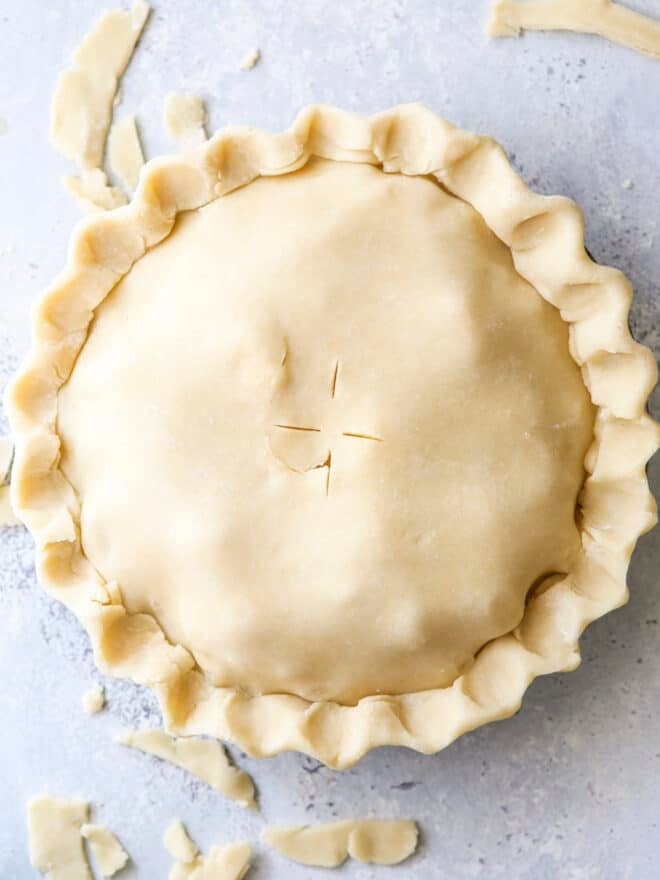
This buttermilk pie crust is my most favorite pie crust recipe! If you’d never substituted buttermilk for water in your pie crust, then you are missing out on an opportunity to add SO MUCH FLAVOR to your pie.
Swap out water for buttermilk and the result is a crust that is tender and flaky, with incredible rich flavor all on its own. And it’s no longer a supporting character, but a co-star, and this buttermilk pie crust makes my pies shine every time.
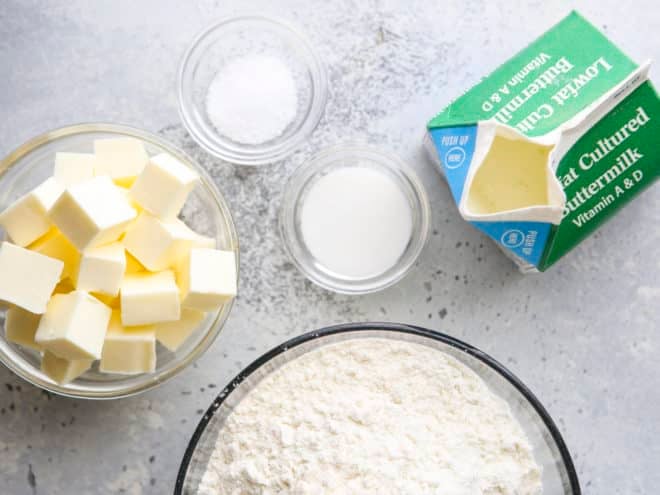
Ingredients You’ll Need
- All-purpose flour
- Cold unsalted butter
- Granulated sugar (optional, but I always add for dessert pies)
- Coarse salt
- Cold buttermilk
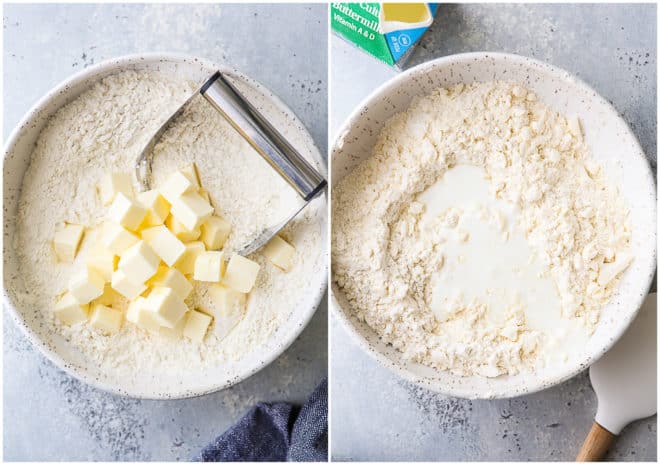
How to Make Buttermilk Pie Crust
You can prepare this pie crust however you like—in a bowl with a pastry blender (shown here), using my foolproof flaky crust method, or even in your food processor. No matter how you do it, they all follow these basic steps.
- Combine dry ingredients. Combine flour, salt, and sugar (if using).
- Cut in butter. Add cubed cold butter and cut into dry ingredients using pastry blender (or other method) until butter is the size of peas.
- Add buttermilk. Add buttermilk and stir with a spatula or spoon until it starts to come together. Dump mixture out onto a clean surface and mix with your hands until it holds its shape.
- Shape into disks. Divide and shape into two disks and wrap in plastic wrap.
- Chill completely. Chill in the fridge for at least 1 hour before using.
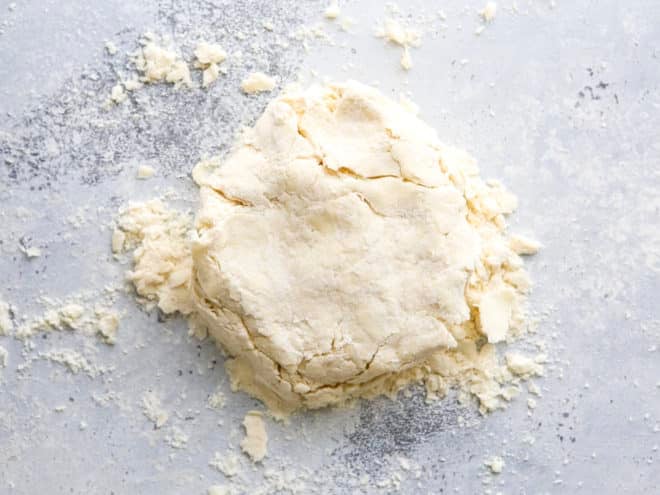
Tips for this Pie Crust Recipe
- Always start with cold butter and buttermilk. This ensures the butter stays separate from the flour, rather than incorporating into it, so the little pockets of butter create rise and flakiness as the pie bakes.
- The reason you add much more buttermilk to this recipe than you would water is because buttermilk is a lot thicker than water, and so you’ll need more of it.
- I exclusively use “cultured buttermilk” in all of my baking recipes, as real buttermilk is difficult to find. (Read more about the differences here)
- If you don’t have buttermilk, you can make your own by adding ½ tablespoon lemon juice to a liquid measuring cup and adding regular milk to the ½ cup mark. It doesn’t taste exactly the same, but it can work in a pinch.
How to Make Pie Crust Ahead of Time
Pie crust freezes really well! Make a big batch and refrigerate or freeze to use at another time.
- How to store pie crust in the freezer— Double wrap in plastic wrap and store pie crust in the freezer for up to 2 months. When ready to use, defrost in the fridge overnight.
- How to store pie crust in the fridge— Wrap in plastic wrap and store pie crust in the fridge for up to about 5 days. If wanting to store for longer, use the freezer.
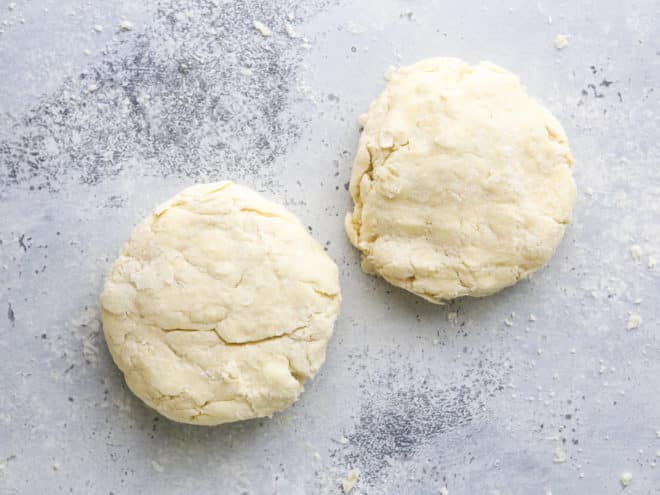
Pies to Bake with this Recipe
Shop Tools for this Recipe
This recipe was originally published October 2015.
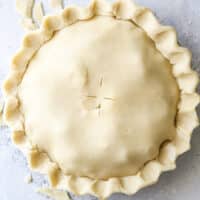
Buttermilk Pie Crust
Ingredients
- 2 ½ cups all-purpose flour (300 grams)
- 1 tablespoon granulated sugar , optional
- 1 teaspoon salt
- 1 cup unsalted butter , cold and cut into cubes (226 grams)
- ½ cup cold buttermilk (120 ml)
Instructions
- Combine the flour, sugar (if using), and salt in a bowl. Add the cubed butter and toss to coat.
- Use a pastry blender or two knives to cut the butter into the dry ingredients until butter is the size of peas.
- Add buttermilk and use a spoon and then your hands to stir the mixture until it comes together into a ball. If mixture is too dry, add additional buttermilk a teaspoon at a time.
- Divide the dough in two and flatten into disks. Wrap each disk in plastic wrap and chill in the fridge for at least 1 hour and up to 5 days. Dough can also be frozen (double-wrapped) for up to 2 months.
- When ready to roll out, let the dough rest at room temperature for five minutes. On a lightly floured surface, use a rolling pin to roll out the dough into a rough 13 inch circle. Dough should be about 1/4 inch thick. Transfer dough to 9-inch pie dish. Fill pie with desired filling.
- Repeat with the second disk of dough. Cut dough and make a lattice over the filling, or leave the circle intact and cover the filling completely, cutting a few vents with a sharp knife.
- Fold the edges of the top and bottom crusts together and use your index fingers and thumb to pinch into a pattern. Brush with egg wash and sprinkle with sanding sugar, if desired.
- Bake pie according to the instructions in your specific pie recipe. Different fillings will require different temperatures and time.
Notes
NOTES
- Makes enough dough for one 9-inch double pie crust.

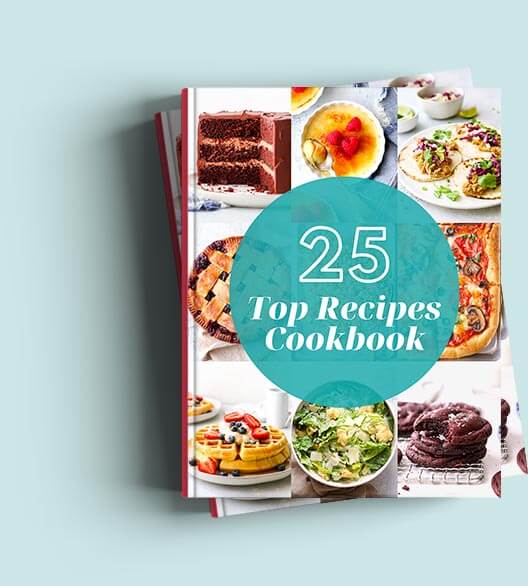
I love the idea of this! I make the same pie crust over and over and this is the perfect way to switch it up!
Wow, it rolls out 1/4 inch thick? Right on! I LOVE the big Costco apple pies with their super thick crusts and this sounds along the same lines. Is that why it’s sturdy enough to make the galettes? I was thinking about making a slab pie for the next work potluck and I’ll definitely try out this buttermilk crust. Thanks!
Yes, I love thick crusts too! You’ll have to let me know what you think if you give it a try. Thanks Erin!
love this one!! Hope you are doing well
I noticed that both of your crust recipes use more than twice the liquid of other recipes. Is that because you “roll” the butter in?
Do you recommend using this recipe for all other pies or just fruit filled pies?
I use it for all of my pies!
Great tasting, easy to follow instructions. It came out great after the first try!
I’m enjoying learning this crust and how it fits with my baking. It’s a good recipe, easy to follow and leaves room for tweaking. This is an excellent foundational crust. Thank you for posting it!
Can I use this recipe for a pre-bake crust ? If so how long and at what temperature shall I bake the pie crust.
Yes you can! See my post on how to blind bake a pie crust. 🙂
Used while making a rhubarb pie! Came out great and I liked the sheeting rolling technique!
Yes!! I’m so happy to hear it worked out so well!
I’m a little confused on the directions of cutting in the butter. In the tips you say to use a pastry cutter, but in the recipe you use a rolling pin, do they both work?
My apologies for the confusion! Yes both methods work and I’ve fixed the recipe.
Half a cup of buttermilk or 160 mL? Half a cup of buttermilk is typically 120 mL. 160 mL is typically 3/4 of a cup. Which one is it?
Thank you for catching me error! It should be approximately 1/2 cup, or 120 ml. But as with all pie crusts, only add what you need to get the dough to hold together.
I don’t see anything to click on so that I can PIN your recipes to Pinterest! What am I missing??? Thank you for your help.
Can you use this for chicken pot pies? Omit sugar?
Definitely! That’s exactly what I do.
Well, I love buttermilk in my recipes and I also enjoy drinking it with a little salt on top!! Yummy and good for you! The moisture it adds to cakes, biscuits, and more is well known. However, it never crossed my mind to use it as the wetting agent for my pie crust! What a pleasant surprise to see how it turned out!! The subtle flavor of the buttermilk was such a nice addition to the flaky layers it produced in this tender crust for my peach pie! This will be my go to recipe from here on out after using my standard for over 30 years! Thanks so very much!!
I’ve been making pie crust for 50 years. I had some leftover full-fat buttermilk and wanted to use it. Tried your recipe. I needed a lot more buttermilk than the recipe called for to get the dough to come together. I used the dough to make a peach cobbler, baking it at 350 degrees. Looked great when it came out of the oven. When I tried it the dough was tough. I didn’t overwork the dough. I’m wondering if anyone else has had this issue. Dough tastes good. The bottom dough is tough and the top dough is crunchy. Anyone else have this problem? Dough is very easy to make, btw.
I’m not sure what I did wrong…making the crust went well, and rolling it out. My recipe called for pre-baking, so I put in a parchment paper round and some lie weights. When I took it out of the oven, it was asoggy mess. It looked like all the butter had just melted and leaked out of the crust.